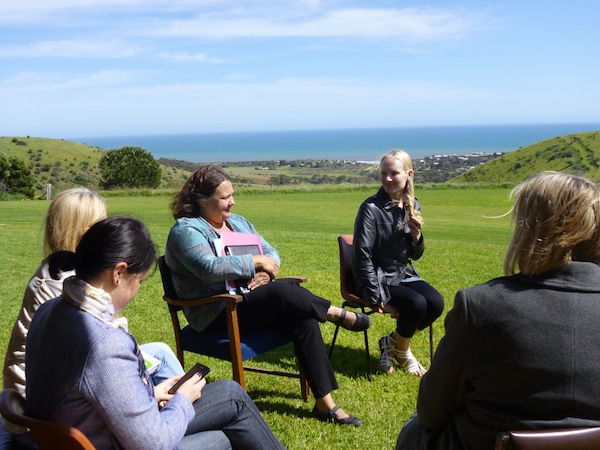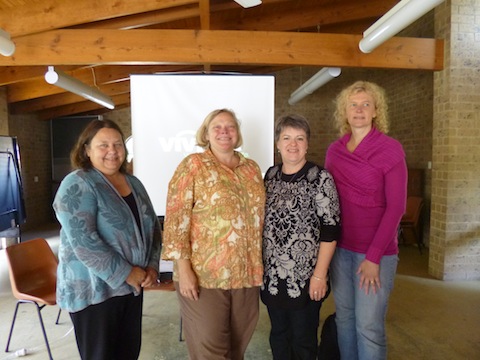
Skolotājas pārrunā vasaras vidusskolas programmas ar Garezera Vasaras Vidusskolas direktori, Sandru Kronīti-Sīpolu. Foto: Līga Dārziņa.
Austrālijas latviešu skolotāji no Sidnejas, Melburnas un Adelaides septembra pēdējā nedēļas nogalē satikās latviešu iemīļotajā īpašumā “Dzintari” un pusotru dienu klausījās dažādas uzrunas, kā arī pārrunāja izaicinājumus, kas šobrīd skar visas latviešu skolas ārpus Latvijas.
Konferences īpašās viešņas no ASV – Elisa Freimane un Sandra Kronīte-Sīpola bija galvenās runātājas un dalījās pieredzē ar to, kā darbojas ASV latviešu skolas, kā arī Garezera vasaras vidusskola
Sandra Kronīte-Sīpola konferenci iesāka ar svarīgu vēstījumu, apstiprinot to, ko daudzi skolotāji jau ir pieredzējuši savās latviešu skolas klasēs pēdējos pāris gados. Bērni ir mainījušies; internets ir izmainījis mūsu vidi. Informācijas plūsma bērniem acu priekšā ir nemitīga, tā mūžīgi ienāk un bērni bieži vien vairāk zina par skolotājiem, īpaši tehnoloģiju jomā. Bērni ir pieraduši saņemt informāciju momentā un skolotājiem, kas pieraduši klases priekšā stāvēt, jāaatrod jaunus mācīšanas paņēmienus, lai piesaistītu bērnu uzmanību.
Mēs kā latviešu skolas nevaram sevi izolēt no ārējās pasaules un tāpēc ir jāspēj pielāgoties bērniem. Jaunajā mācīšanās modelī bērniem, kam dabiski patīk sadarboties ir jāveicina mijiedarbi un tāpēc skolēns tiek likts uzmanības centrā, nevis skolotājs. Bērni mācās viens no otra, viens otru atbalsta un skolotāja loma ir kā šīs darbošanās koordinētājam. Skolotājs kā koordinētājs (“facilitator”) zina mērķi, ko sasniegt, bērni paši meklē informāciju.
Tai pat laikā mūsu skolēni vēlās justies īpaši un latvietība ārpus Latvijas mūsu bērniem ir sevišķa. Tā viņus atšķir no citiem un viņi par to lepojas, vajag viņiem tikai šo pasauli atklāt.
Sandra uzsvēra, ka piemērs tam, ka var mazliet tradīcijas izmainīt ir skolēniem dot iespēju vadīt sarīkojumu. Bērni ir spējīgi, pat 5 gadīgs bērns varētu dienas sākumā novadīt rīta lūgšanu. Bērniem tikai vajag kārtīgi izskaidrot, kādēļ viņiem tas jādara un ja viņi saprot, kurp viņi iet – ceļa mērķi, vai jēgu – tad viņiem arī ir prieks piestrādāt.
Tika uzsvērts arī fakts, ka starp 3 un 6 gadiem ir no smadzeņu attīstības viedokļa vecums, kad mums būtu bērniem visvairāk jāmāca, un nebūtu vienmēr jāgaida līdz vecākajām pamatskolas klasēm mācīt bērniem tradicionāli sarežģītus tematus par Latviju. Šinī vecuma grupā vajadzētu kā skolotājus iedalīt vislabākos, iedvesmojošākos skolotājus jo šinī vecumā bērnu smadzenes ir kā sūkļi un šo attīstības posmu vajag izmantot pilnībā.
Latviešu skolas programmu sastādot ir jāskatās uz to, kas mums šķiet katram latviešu bērnam jāzina izejot pasaulē – valoda, tikumi, saprašana par latvieša dabu kā arī par Latvijas dabu, vēsture. Klāt vēl nāk izpratne par latvieša mākslas izjūtu, ko ASV latviešu skolas šogad izmēģināja savā vasaras programmā. Bērniem dažādās vecuma grupās bija jāizsaka savas domas par Evalda Dajevska mākslas darbiem. Uzdevumu veicot bērniem attīstās radošā domāšana un tajā pat laikā rodas izpratne par estētiski latviskām vērtībām.
Vēl citi paņēmieni, ko tagad arī jau izmanto skolas Rietumu pasaulē ir vingrošana. No paša rīta bērniem ieteicams novadīt stundu ar fiziskām aktivitātēm, kur mācībās nav iekļauta rakstīšana. Vispār dienas sākumā mācību stundas jāievada tā, lai vide bērnam būtu pozitīva, jo katram skolēnam svarīga ir emocionāli droša vide. Ja tādas nav, tad saspringuma līmenis ir augsts un skolēns vispār “atslēdzas”, ja ir grūtības uztvert vielu.
Sakarā ar lasīšanu un mūsu bērnu “operatīvo atmiņu” – pētījumi ir atklājuši, ka labāk ir mācīt mazāk, pa mazām daļām, un informāciju vēlams atkārtot. Vārdiem, ko māca jābūt kontekstā, atsevišķus vārdus mācīt nav vēlams. Jaunus vārdus mācīt pa tēmām – jēgpilni – ar skaidru mērķi bērniem ir daudz vieglāk uztvert un atcerēties.
LAAJ Izglītības nozares vadītāja Zinta Ozoliņa turpināja šo tēmu – par jaunākiem atklājumiem neirozinātnē un uzsvēra, ka šodienas skolotājiem skaidri jāzina, ko viņi vēlās, ka bērni katrā stundā iemācās un par to jāuzņemās atbildība. To jāpaziņo skolēniem un tad jāuzzina no skolēniem, ko viņi par šo tēmatu jau zina. Skolotājam tāpēc jābūt elastīgam un jābūt gatavam mainīt to, ko viņš māca, lai piemērotos skolēnu vajadzībām.
Šinī mācību modelī svarīgākais ir process. Klasē bieži pēta un pārrunā jau iepriekš mājās veiktus darbus – nosaukums šim modelim ir “flipped classroom”, jo mācīšana notiek pretēji ierastajam modelim. Jauno vielu skolēni apgūst mājās no video ierakstiem, kas pieejami internetā. Skolotāja loma klasē ir pārrunāt, izvērtēt mājās apgūto vielu, izskaidrot neskaidrības. Skolotājs vairs nav galvenais informācijas avots, bet gan veic skaidrotāja un tēmas tālākattīstītāja funkciju.
Elisa Freimane pievērsās tieši latviešu skolu modelim vecākajām pamatskolas un vidusskolas vecuma klasēm. Latviešu skolā ir jāpieņem, ka nekas nav vairs pašsaprotams. Ja agrāk skolēniem bija līdzīgas valodas zināšanas, tad tagad nevar pieņemt, ka visi sapratīs jēdzienus, vārdus un ka vispār būs dzirdējuši par latviešu klasikas autoriem, vai literāriem darbiem.
Katrā mācību stundā ir jāiegulda laiks, sagatavojot bērniem skaidrojumu par tēmu, vēsturisko laika posmu, kurā darbība risinās un vispār iemeslu, kāpēc šis darbs ir svarīgs. Ir svarīgi uzsvērt, ka skolēnam jāapzinās, ka iespējams, ka visu lasāmo gabalu viņš nesapratīs un tam nav jābūt šķērslim to mācīties, jo galvenais ir diskusija, ko darbs izraisīs. Skolotāja darbs ir pārliecināt skolnieku, ka tieši šo literāro darbu ir vērts mācīties un izskaidrot iemeslus. Ar šādu ievadu skolēnam jau radusies interese uzzināt vairāk.
Elisa arī paskaidroja vairākus veidus, kā var bērniem padarīt patīkami izprast šķietami sarežģītus tekstus. Piemērs ir Blaumaņa Tālavas taurētāja atstāstījums, lietojot vienkāršas plastmasas figūriņas. Atstāstījuma mērķis ir saprast, vai skolēns ir mācību procesā izpratis dzejas galveno jēgu. Vairāk nevajag no skolēna sagaidīt.
Elisa arī pievērsās valodas līmeņa atšķirībām: vai to ir jāuzskata par problēmu. Austrāļu un amerikāņu skolās retā skolā vai klasē ir bērni ar vienlīdzīgām zināšanām. Skolēnus uzskata par indivīdiem, kas ir daļa no grupas – nevis otrādi. Latviešu skolās dabiski būs valodas spēju atšķirības un vecāki nogrupēsies pa grupām ar atšķirīgām prasībām no skolas. Skolai kā saimei ir jāspēj vecāku atšķirīgās vajadzības uzrunāt un izvērtēt, vai skolai ir resursi, lai tā spētu apmierināt dažādās vajadzības.
Konferencē ar saviem iespaidiem par Skolotāju konferenci Latvijā šī gada jūlijā dalījās Melburnas skolas pārzine, Līga Dārziņa un skolotāja Inga Jakse. Viens no galvenajiem tematiem, kas bija abas skolotājas uzrunājis bija “diferencētā” mācību viela – ka mācībās sagatavo vielu par līdzīgu tēmatu vai jēdzienu bet darba lapas ir dažādas, pēc valodas spējām.
Zinta Ozoliņa bija sagatavojusi īsu pārskatu par bieži pamanītām valodas kļūdām piem. man jāmazgā traukus vai man jāmazgā trauki. Kuros brīžos lietot “jeb” un kuros “vai” un citas bieži dzirdētas un redzētas valodas kļūdas, kas ieviesušās no burtiskas tulkošanas no angļu valodas.
Svētdienas pēcpusdienā bija iespēja ar Arni Grosu praktiski izmēģināt savas spējas izveidot mācibu stundas lietojot iPad datorus, ko tagad var daudzpusīgi izmantot jaunākajās klasēs mācot valodu. Vērtīgas arī bija diskusijas ar Sandru Kronīti (Garezera vasaras vidusskolas direktori) par vasaras vidusskolām un to, kā vislabāk veidot jēgpilnu un reāli izpildāmu vasaras mācību programmu.
Kopumā skolotāji bija ļoti apmierināti ar konferences vietu, laiku, lekciju saturu. Vēlme pēc lielākām iespējām pārrunāt sāpīgus tēmatus būs noteikti jāiekļauj nākamajā skolotāju konferencē, kā arī iespēju izmainīties mācību materiāliem, kā arī uzzināt par jaunām Latvijā iznākušām grāmatām un metodiskiem līdzekļiem, kas saistīti ar otrās valodas apguvi. Pēc konferences visi skolotāji tika uzaicināti elektroniski pievienoties Austrālijas latviešu skolotāju “Dropbox” kontam, kur iespēja jau šogad pievienot un dalīties ar mācību vielu, programmām un mācību plāniem.
Ceļa izdevumus uz Austrāliju vieslektorēm no ASV sedza Latviešu valodas aģentūra no naudas līdzekļiem, kas iekļauti Latvijas Izglītības un zinātnes ministrijas budžeta programmā “Valsts valodas politika un pārvalde”.

ASV vieslektores Sandra Kronīte-Sīpola un Elisa Freimane ar LAAJ Skolu nozares vadītāju Zintu Ozoliņu un PBLA Izglītības padomes priekšsēdi Dainu Grosu. Foto: Līga Dārziņa.



